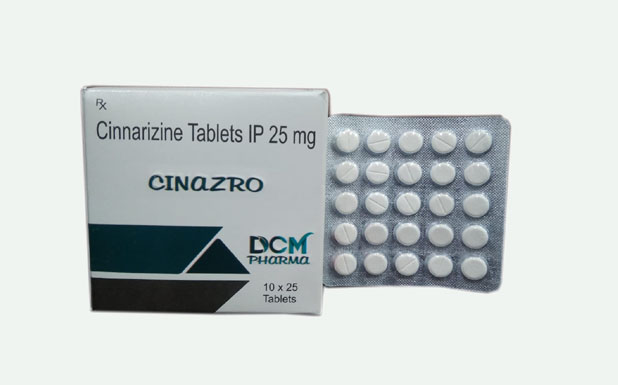Vomiting is controlled by an area of the brain called the vomiting centre. The vomiting centre is responsible for causing feelings of sickness (nausea) and for the vomiting reflex. It is activated when it receives nerve messages from the vestibular apparatus in the middle ear.
The vestibular apparatus provides continual feedback to the brain about our body position. When something disturbs the vestibular apparatus, such movement of the head when travelling by boat or car, nerve signals are sent from the vestibular apparatus to the vomiting centre. This can cause sensations such as nausea, dizziness or spinning sensations (vertigo) and the reflex of vomiting.
Cinnarizine works by blocking histamine and muscarinic receptors in the vomiting centre in the brain. This prevents the vomiting centre from receiving nerve messages from the vestibular apparatus. In turn, this prevents disturbances in the middle ear from activating the vomiting centre and causing nausea, vertigo and vomiting.
Indications:
● Preventing and treating motion sickness.
● Relieving nausea, vomiting, attacks of dizziness or spinning sensations (vertigo) and sensations of ringing or other noise in the ears (tinnitus) associated with Meniere's disease and other middle ear disorders.
Pharmacology:
Mechanism of Action:
Cinnarizine inhibits contractions of vascular smooth muscle cells by blocking L-type and T-type voltage gated calcium channels. Cinnarizine has also been implicated in binding to dopamine D2 receptors, histamine H1 receptors, and muscarinic acetylcholine receptors.
Pharmacodynamics:
Cinnarizine is an anti-histaminic drug which is mainly used for the control of vomiting due to motion sickness. It acts by interfering with the signal transmission between vestibular apparatus of the inner ear and the vomiting centre of the hypothalamus. The disparity of signal processing between inner ear motion receptors and the visual senses is abolished, so that the confusion of brain whether the individual is moving or standing is reduced. Vomiting in motion sickness is actually a physiological compensatory mechanism of the brain to keep the individual from moving so that it can adjust to the signal perception.
Cinnarizine could be also viewed as a nootropic drug because of its vasorelaxating abilities (due to calcium channel blockage), which happen mostly in brain. It is also effectively combined with other nootropics, primarily piracetam; in such combination each drug potentiate the other in boosting brain oxygen supply.
Warnings:
●This medicine may cause drowsiness, so caution should be taken while driving or operating machinery.
●You should not drink alcohol while taking this medicine, as this is likely to make drowsiness worse.
●If you are due to have any skin prick tests to diagnose allergies you should stop taking this medicine at least 48 hours before the tests. This is because antihistamines can prevent or lessen the skin reactions that indicate an allergy, and so can make the test results unreliable.
Contraindications:
Contraindicated in patients with Parkinson's disease, newborns, and hypersensitivity.
Side Effects:
●Central Nervous System - Drowsiness, headache, GI upset, unsteadiness, headache, depression dizziness and incoordination.
●Skin - Rash.
●Gastrointestinal - Nausea, vomiting, diarrhea or constipation, loss of appetite or increased appetite and stomach pain.
●Miscellaneous - Weight gain, perspiration or allergic reactions and urinary difficulty or retention.
Storage:
Store it at room temperature (25°C).
